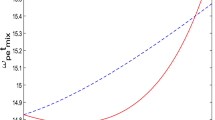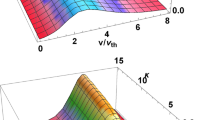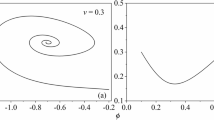Abstract
In this article, contrary to what is known previously, a randomized dusty plasma model is introduced. In this new issue, the uncertain properties of the plasma nonlinear system are assumed as continuous random variables. Hence, a comprehensive probabilistic behavior of the interesting characteristics of the dusty plasma wave is presented through computing the first probability density functions and consequently the means, the variances and the confidence intervals. For this goal, a probabilistic transformational technique that is known as the random variable transformation is implemented. The obtained theoretical findings are investigated via some numerical results that showed acceptable consistency with the physical situations.








Similar content being viewed by others
References
P. K. Shukla and A. A. Mamun, Introduction to Dusty Plasma Physics (Institute of Physics, Bristol, 2002).
N.N. Rao, P.K. Shukla, M.Y. Yu, Planet. Space Sci. 38, 543 (1990). https://doi.org/10.1016/0032-0633(90)90147
F. Verheest, Waves in Dusty Space Plasmas (Kluwer, Dordrecht, 2000)
A.A. Mamun, Astrophys. Space Sci. 268, 443 (1999). https://doi.org/10.1023/A:1002031022895
F. Sayed, A.A. Mamun, Phys. Plasmas 14, 014501 (2007). https://doi.org/10.1063/1.2408401
A. Barkan, R.L. Merlino, N. D’Angelo, Phys. Plasmas 2, 3563 (1995). https://doi.org/10.1063/1.871121
R. Walpole, R. Myers, S. Myers, Probability and Statistics for Engineers and Scientists (ninth ed., Prentice-Hall, New Jersey, ch.7, pp 211–217, 2012).
A. Papoulis, Probability, Random Variables and Stochastic Processes (fourth ed., McGraw-Hill, Boston, USA, ch.5, pp 123–138, 2002).
A. Hussein, M.M. Selim, Eur. Phys. J. Plus 135, 418 (2020). https://doi.org/10.1140/epjp/s13360-020-00389-6
H. Slama, A. Hussein, N.A. El-Bedwhey, M.M. Selim, Appl. Math. Comput. 361, 144 (2019). https://doi.org/10.1140/epjp/i2017-11763-6
A. Hussein, M.M. Selim, J. Quant. Spectrosc. Radiat. Transfer 232, 54 (2019). https://doi.org/10.1016/j.jqsrt.2019.04.034
A. Hussein, M.M. Selim, Eur. Phys. J. Plus 130, 249 (2015). https://doi.org/10.1140/epjp/i2015-15249-3
H. Slama, N.A. El-Bedwhey, A. El-Depsy, M.M. Selim, Eur. Phys. J. Plus. 132, 505 (2017). https://doi.org/10.1140/epjp/i2017-11763-6
A. Hussein, M.M. Selim, Appl. Math. Comput. 218, 7193 (2012). https://doi.org/10.1016/j.amc.2011.12.088
J.C. Cortés, A. Navarro-Quiles, J.V. Romero, M.D. Roselló, Math Meth Appl Sci. 2019(42), 5708 (2019). https://doi.org/10.1002/mma.5440
J.C. Cortés, A. Navarro-Quiles, J.V. Romero, M.D. Roselló, Appl. Math. Lett. 68, 150 (2017). https://doi.org/10.1016/j.aml.2016.12.015
J.C. Cortés, A. Navarro-Quiles, J.V. Romero, M.D. Roselló, J. Comput. Appl. Math. 324, 225 (2017). https://doi.org/10.1016/j.cam.2017.04.040
H. Washimi, T. Taniuti, Phys. Rev. Lett. 17, 996 (1966). https://doi.org/10.1103/PhysRevLett.17.996
F.F. Chen, Introduction to Plasma Physics and Controlled Fusion, 3rd edn. (Springer, Switzerland, 2016)
Author information
Authors and Affiliations
Corresponding author
Appendices
Appendix
Deterministic model
2.1 Scaled system of nonlinear differential equations
The system of coupled nonlinear partial differential Eqs. (1–3) before scaling takes, respectively, the form [1, 2];
In addition, Eq. (4) before scaling is
In Eqs. (53–56), if the scaled variables \(n_{d} = \frac{{N_{d} }}{{n_{d0} }},\,\)\(\,n_{i} = \frac{{N_{i} }}{{Z_{d} n_{d0} }},\)\(\,n_{e} = \frac{{N_{e} }}{{Z_{d} n_{d0} }},\,\)\(u_{d} = \frac{{U_{d} }}{{C_{d} }},\) \(\phi = \frac{e\Phi }{{k_{B} T_{i} }},\) \(x = \frac{\xi }{{\lambda_{D} }}\) and \(t = \tau \omega_{pd} ,\) are introduced; we get, with some algebraic manipulations, Eqs. (1–4), where \(n_{d0}\) is the unperturbed negative dust density, \(C_{d} = (Z_{d} k_{B} T_{i} /m_{d} )^{1/2}\) is the negative dust sound speed and \(m_{d} ,\,Z_{d}\), \(e\), and \(k_{B}\) are the dust mass, charge number, the electron charge and Boltzmann constant, respectively. In addition, \(\lambda_{D} = \left( {k_{B} T_{i} /4\pi Z_{d} e^{2} n_{d0} } \right)^{1/2}\) is the negative dust Debye radius and \(\omega_{pd}^{ - 1} = (m_{d} /4\pi Z_{d}^{2} e^{2} n_{d0} )^{1/2}\) is the negative ion plasma period.
2.2 Deterministic solution
The KdV equation, Eq. (13), can be derived from Eqs. (1–4), by employing the reductive perturbation method (RPM) [18]. In this method, the independent variables are stretched to \( X = {\epsilon}^{1/2} (x - v_{0} t),\,\,\,T = {\epsilon}^{3/2} t\), and hence
where \(\epsilon\) is a small (real) parameter and \(v_{0}\) is the phase velocity. The dependent variables are expanded according to Eq. (9). Substituting the variable stretching (57) and the expansions (9) in Eqs. (1–3), we get the following:
-
(i)
For the continuity Eq. (1)
Equating the coefficients of the first and the second orders of \(\epsilon\) in (58) to zero gives, respectively,
-
(ii) For the momentum Eq. (2)
Equating the first and the second orders of \(\epsilon\) to zero gives, respectively,
Substituting the variable stretching (57) and the expansions (9) in (64), we get
For the zero order of \(\epsilon\), we have the neutrality condition:
Equating the coefficients of the first and the second orders of \( \epsilon\) to zero gives, respectively,
Integrating (59) and (62), under the boundary conditions: \(\,\,u(X) \to 0,\) \(\phi^{(1)} (X) \to 0\) at \(|X| \to \infty ,\) gives
Substituting the value of \(n_{d}^{(1)}\) in (66) provides the compatibility condition
This leads to the following expression for the phase velocity
Delete the term \(\frac{{\partial u_{d}^{(2)} }}{\partial X}\) between Eqs. (60) and (63) to get
Substitute \(n_{d}^{(1)}\) and \(u_{d}^{(1)}\) from (68) in (70) to get
Differentiate (67) to get
Substitute \(\frac{{\partial n_{d}^{(2)} }}{\partial X}\) in Eq. (71) and arrange the terms to get the required KdV equation:
Or
where the coefficients of nonlinear and dispersion terms are given by Eq. (14).
In order to solve the KdV (73), analytically, we introduce the transformation \(\zeta = X - u_{0} T\), where \(\zeta\) is the transformed coordinate with respect to a frame moving with a speed \( u_{0}\) normalized to \(C_{d} .\) Setting \(\phi^{(1)} (X,T) \equiv u(\zeta )\) in (73) and integrating the resulting equation under the boundary conditions (15) lead to Eq. (16). Multiply (16) by \(\frac{du(\zeta )}{{d\zeta }}\) and integrate to get
or
Equation (74) is a separable first-order differential equation that can be easily solved to get the solution (17).
Rights and permissions
About this article
Cite this article
Hussein, A., Selim, M.M. Propagation of dust acoustic waves in multi-components plasma with random parameters. Eur. Phys. J. Plus 136, 797 (2021). https://doi.org/10.1140/epjp/s13360-021-01746-9
Received:
Accepted:
Published:
DOI: https://doi.org/10.1140/epjp/s13360-021-01746-9




